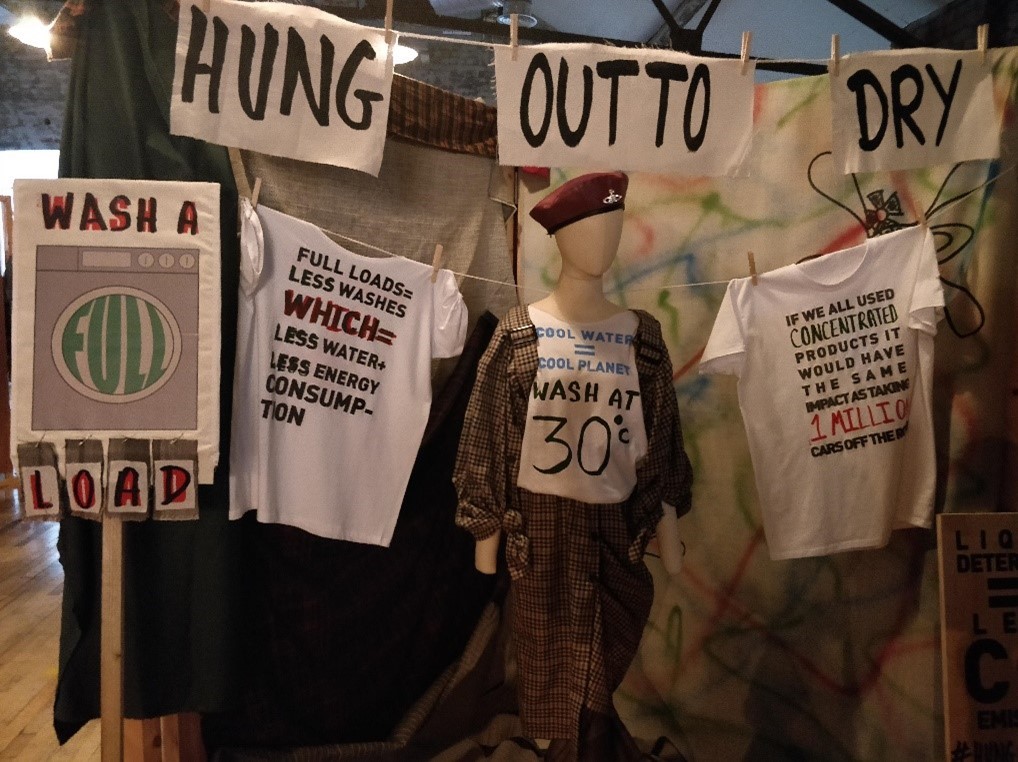Summary
Unilever’s Art, Archives, and Records Management (UARM) team, based at Port Sunlight on The Wirral- Unilever’s historic home in the UK – has a culture of collaboration with colleagues from both the academic and creative sectors. The team was intrigued by an approach in early 2019 from Dr Lee Wright, Senior Lecturer in Design History at Liverpool John Moores University, who wanted to bring her second-year fashion design students to see design material in the archives.
Unilever’s archive collections feature, amongst other kinds of records, minute books detailing the company board meetings, financial records, advertising and examples of packaging for a host of past and current brands including Colman’s, Wall’s, Persil/Omo, Dove, Hellman’s and Marmite. It also includes architectural plans and maps of current and former Unilever sites.

Student-created imagery for ‘environmentally sound laundry practices’ campaign. Image courtesy of Unilever Art, Archives and Records Management.
Challenges and opportunities
Dr Wright was keen to highlight to the students the importance of primary research and looking beyond the screen to encounter the materiality of records and objects. After initial discussions with the archive service and a tour around the archive facilities at Port Sunlight, a module based on Unilever’s archives and the organisation’s business values was developed. Nine distinct brands, including Coleman’s, Magnum, Pot Noodle and Persil, were chosen and the archive service shared information and images about each brand.
In October 2019, the archive service welcomed 50 students in their second year of a fashion design and communications course. The team showed the students examples of adverts and packaging from the collection and explained how they dealt with licensing copyrighted materials. The students asked lots of questions about fonts, colours, logos and took lots of photographs throughout the visit. They were split into two groups, based on their assignments for the module. One group’s aim was to produce an item or garment whilst the second group’s aim was to form a communication campaign.
A month later, colleagues from the archive service visited the University to see what the students had produced and were ‘blown away‘ by the ideas, the mood boards, samples and the further research they had undertaken in response to their encounters with the Unilever collection. One student had merged the Wall’s and Levi’s brands, another had created a coat that transformed into a bag (or vice versa), and a further student had created a campaign for Persil that took inspiration from Vivienne Westwood to highlight ‘environmentally sound laundry practices’.
“The research and development enabled the students to exhibit an authentic and original collaborative project utilising their concept and a Unilever brand, which reflected their own creative vision.”
Paul Robinson, Senior Lecturer
Outcomes
The students got a chance to consider brand and identity from a different position and to see, handle and engage with a wide range of archive material. They also learnt how historical collections actively support a business in its current work and activities, by providing context and inspiration for new innovations. The business got insight into how various brands are seen and considered from a key audience sector.
A fashion show was held in Liverpool with a second planned for the Unilever offices in central London for March 2020 but had to be cancelled due to the onset of the Covid-19 pandemic.
What was learned from the process?
Working with the students in this way had a surprisingly profound impact on the archive service staff and contributed to a change in how the team perceived the items in their care with regard to their potential use and reuse.
“Viewing our brands through the lens of fashion students has been incredibly inspiring and energising. It has made us think more creatively about how people view and use our collection. Our team have also learnt a lot from this collaboration.”
Claire Tunstall, Global Head of UARM
Creative engagement is embraced whether from academic collaboration or working with artists and the archive service is keen to actively reflect this. The experience gave the Unilever team more confidence in the process and to collaborate on more creative projects and initiatives. For example, in 2019 Unilever Archive hosted a temporary exhibition at Port Sunlight Museum called ‘What’s behind the U’.
Key advice
The Archive Service Accreditation scheme has been an important framework for the team at Unilever as they have grown their engagement and partnerships with external stakeholders.
The standard itself and the application process underline the importance of this kind of work: archive services have the opportunity to demonstrate within their application what kinds of access and engagement they provide and discuss who they work with to bring their collections to new audiences.
First accredited in 2014 and then again in July 2020, the Archive Service Accreditation panel commended the engagement and audience development work of Unilever’s archive service in its most recent assessment. This work “builds partnerships and creates possibilities for the future as well as strengthening the service’s current position”.
How will this work be developed in the future?
The team at Unilever are looking to repeat this process with a new intake of students, using different brands, and are also considering how they can increase access to the final creative responses.
Other partnerships and engagement work is also ongoing. For example, the archive service has co-collaborated with Port Sunlight Village Trust on SoapWorks at Port Sunlight, which is a permanent exhibition about the science of soap and the story of how William Lever went from selling soap to creating a multi-national company. The project included working with museum curators and reflecting on the nature and purpose of interpretation.
Find out more
The Unilever Archives webpages includes a Contact Us webform.
Relevant resources
The National Archives’ Guide to collaboration for archives and higher education (PDF, 4.8 MB)
Business Archives Council’s Facilitating academic-archivist collaborations in business (PDF, 250 KB)